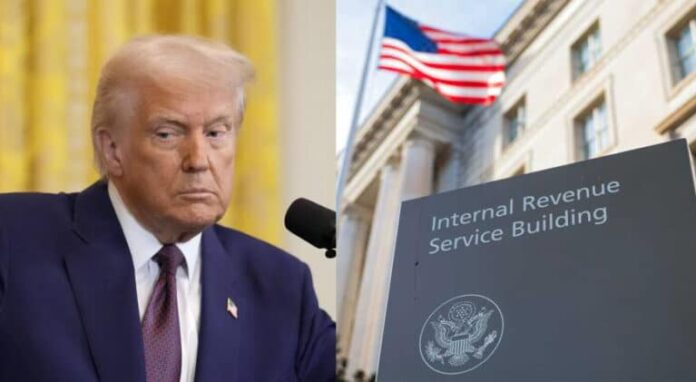
Fiscal Flashpoints:
- Trump reportedly eyeing bold plan to eliminate federal income taxes for Americans earning $150,000 or less.
- While mainstream media stays focused on falling stocks and tariffs, they quietly ignore this potential tax bombshell.
- New tariffs and spending cuts could shift America’s economic landscape, creating long-term prosperity.
By Samuel Lopez — USA Herald
April 15th marks Tax Day—the deadline for millions of Americans to submit their state and federal income taxes. Could Trump’s next major announcement signal the end of federal income taxes for those earning $150,000 or less?
Imagine opening your paycheck and not seeing a dime deducted for federal income taxes. It sounds almost too good to be true — but if recent reports and hints from President Donald Trump are any indication, this could soon become a reality for millions of working Americans.
There is growing speculation that Trump may announce the elimination of federal income taxes for individuals earning $150,000 or less. Trump has long called federal income taxes “illegal” and hinted that tariffs and strategic spending cuts could replace traditional tax revenue streams.
Trump’s administration is reportedly exploring a plan that would relieve Americans of one of their heaviest financial burdens: federal income tax. According to tax bracket calculators like TaxAct, a single person earning $150,000 typically pays about $25,500 in federal income taxes annually. Eliminating this would immediately put thousands of dollars back into American pockets.
While critics worry about how the government would replace this massive revenue source, Trump’s team, backed by the Department of Government Efficiency (DOGE), claims it has already identified spending cuts sufficient to offset lost income tax revenue.
The strategy appears to hinge on two major moves: increased revenue from tariffs and possibly implementing a national sales tax. With American consumers spending over $16.1 trillion in just the third quarter of 2024, a modest national sales tax could, theoretically, raise substantial revenue without directly taxing wages.
Moreover, tariffs on imported goods would bring in even more money — while simultaneously encouraging the return of manufacturing jobs to American soil. In theory, this plan would “keep more money in America” and ensure that consumer-driven taxes largely impact wealthier individuals, who account for nearly half of all U.S. consumer spending.
Strangely, mainstream media has largely ignored this potential bombshell. Instead, focusing on recessions, falling stocks and tariffs. But while the media remains silent, many economic experts acknowledge that Trump’s plan could have profound long-term benefits for average Americans.
If timing is everything, this announcement—just days ahead of the infamous April 15th tax deadline—might be the continuation of his April 2nd Liberation Day declaration that millions of Americans have been anticipating.
For American households grappling with inflation, rising interest rates, and economic uncertainty, the elimination of federal income taxes could be a game-changer. Not only would it instantly raise disposable income, but it would also provide relief amid concerns about how tariffs might increase the cost of goods.
Imagine the average family having thousands of extra dollars per year. For many, it would mean paying off debt faster, affording better healthcare, investing in education, or simply breathing a little easier financially.
DOGE: The Secret Weapon?
Critics argue that slashing taxes so dramatically could spike inflation if not paired with massive federal spending cuts. This is where the Department of Government Efficiency (DOGE) comes into play. DOGE has already identified over $2 trillion in potential savings, potentially making the plan financially viable without resorting to rampant money printing.
Although the government collected about $2.4 trillion in individual income taxes in fiscal year 2024, DOGE officials claim that efficiency reforms could offset this.
Payroll taxes that fund Social Security and Medicare — totaling an additional $1.7 trillion — would still require attention. However, administration insiders suggest that even these funds could be shored up through a combination of efficiency measures, tariffs, and selective national sales taxes.
While Trump can only affect federal taxes, individuals can maximize their savings by living in states with no income tax. States like Florida, Texas, and Nevada already impose no state income tax, and others like Mississippi are moving in that direction.
Ohio, for instance, is speculated to be the next state to eliminate income taxes by 2030 if political movements succeed.
Potential Pitfalls: Inflation and Consumer Behavior
Some experts caution that relying on tariffs and sales taxes could shift the tax burden onto consumers. If goods become more expensive, inflation could erode the benefits of eliminated income taxes. That said, lower earners who spend less on luxury goods may come out ahead under this model.
The real test will be whether DOGE’s spending cuts are deep enough and durable enough to maintain fiscal health without resorting to the printing press.
Is This Trump’s Next Big Announcement?
While it’s still uncertain whether Trump will officially unveil this plan in the coming days or weeks, the groundwork appears to be in motion. And if he does — it could signal one of the most transformative moments in U.S. tax history.
One thing is certain: Americans should pay close attention, because the future of their paychecks — and their financial freedom — could hang in the balance.
Fact-Check and Sources:


